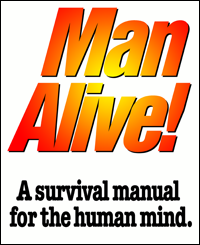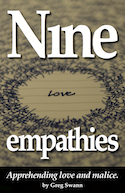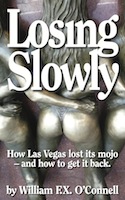From: Man Alive! A survival manual for the human mind.
Extract from Chapter 10. A mindful catalog of mindlessness.
 I like to play a philosophy game I call Backstory. I will look at someone – anyone I happen to see – and try to project backward in time to the past causes of that person’s present-day appearance. Toddlers and young children will have sweet faces, almost always, with no deeper meanings to be discerned. But older children and adults will have had many experiences in their lives, and those past events will have written an emotional history in the lines of their skin. Your mama told you, when you glared and grimaced at her, that your face would freeze like that, but neither one of you knew she was right: The facial expressions we wear most often – habituated Mothertongue emotional reactions – inscribe themselves into our skin. I can see those habitual expressions in the people I am watching. Their clothing and their manner will tell their stories, too, and it is interesting to me to try to suss out their histories, just by looking at people from a distance.
I like to play a philosophy game I call Backstory. I will look at someone – anyone I happen to see – and try to project backward in time to the past causes of that person’s present-day appearance. Toddlers and young children will have sweet faces, almost always, with no deeper meanings to be discerned. But older children and adults will have had many experiences in their lives, and those past events will have written an emotional history in the lines of their skin. Your mama told you, when you glared and grimaced at her, that your face would freeze like that, but neither one of you knew she was right: The facial expressions we wear most often – habituated Mothertongue emotional reactions – inscribe themselves into our skin. I can see those habitual expressions in the people I am watching. Their clothing and their manner will tell their stories, too, and it is interesting to me to try to suss out their histories, just by looking at people from a distance.
I stress that this is just a game. Every living organism, human or not, is in a certain sense a laboratory specimen to me. I am not cruel or intrusive in any way, but I watch everything I am blessed with the opportunity to see, and I learn everything I can from the behavior I observe. In consequence, I can tell you from having run repeated tests that a toddler at around eleven months of age is just about as clueless as dog, when it comes to finding a toy hidden under a shirt, but that same child at thirteen or fifteen months will be able to identify the toy by the distortion of the fabric of the shirt, where the dog will not be able to “see” it, even though the dog actually should “know” by its much better sense of smell that the toy really is there. That’s subjunctivity in its most basic form – the toddler “seeing” an entity that is not immediately obvious to his eyes, identifying it by its much more abstract geometrical shape – and this again is a bright-line distinction between the kind of epistemological method appropriate to a proto-human mind and the method “unthinkingly” deployed by a mere mammal.
I wish I could tell you that I see a lot of Splendor when I play Backstory, but I don’t. I see the basic ingredients of Splendor in the faces of toddlers and young children, but in older children and adults, mostly what I see are accretions of pain – not always full-blown Squalor but way too much of the squalid. But how could this not be the case, given that virtually all of the people I see are trying with all their will and all their mental might to live down to moral philosophies that no one can practice fully without committing suicide – without slaughtering the self of the body because they cannot ever manage successfully to slaughter the self of the mind? This is awful, outrageous, unbearably tragic. But in the long run, nature is just. If you damn your mind and your self completely enough, for a long enough span of time, you go to hell. You just don’t die to get there.










